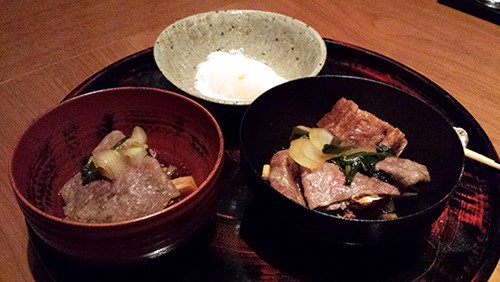I recently explored the food scene in Tokyo and Kyoto and Japan as a food Mecca left me almost speechless. I dont know many cities taking food this seriously. I felt like an amateur starting from scratch and I was learning so much. I loved it.
I was there when the leaves were changing and so were the menus. Chefs were using seasonal ingredients and not because it was the thing to do its what they have always done.
I envy some of Japans winter delicacies and specialties. Here are two that I wish we had more of here.
This is a special occasion dish which is commonly eaten at home with good friends and family during the winter, but it can be served at restaurants.
It is a type of Japanese hot-pot made from a very sweet and savoury broth of soy sauce, sugar, mirin and sake.
There are two types of sukiyaki, Kanto and Kansai, but the two styles can be mixed. With Kanto (Tokyo version) you dip the raw beef into the iron skillet of broth to cook, and with Kansai (Kyoto and Osaka version) the beef is pre-seasoned and pre-cooked before being cooked with everything else.
Hot-pot was historically vegetarian due to the Buddhist influence, but gradually beef was promoted. Premium quality Japanese wagyu or Kobe beef is the key ingredient associated with sukiyaki, thus its a treat to have it. The meat is thinly sliced and accompanied with other vegetables. After it is cooked in the hot-pot the meat is dipped into beaten raw eggs.
The eggs strip away the very sweet and savoury broth which is too much on its on, yet also enhances the broths flavour and gives the beef a bit more richness.
Where to try it in Japan: Kozue at Park Hyatt in Tokyo
Closest thing to it in Vancouver: Shuraku, Aki Japanese and a few other places, but theyre not necessarily the best representations.
Cod milt is also known as Shirako or cod sperm. (That was a way to get your attention, hey?) I first tried it at Incanto in San Francisco, and I havent seen it since. I had it four times in Japan, a couple times sashimi style, and now I like and appreciate it.
It looks like a clump of brain and it is not appetizing to look at, but its a winter delicacy in Japan and its an honour to have it served to you. The texture is of creamy, rich, and soft durian, but the flavour is very mild. Its not fishy, salty, savoury or sweet, but rather neutral. A fresh one should be clean in flavour and not fishy.
 Where to try it in Japan: You can find it at many places, but its reliable at Tsukiji Fish Market in Tokyo, and I liked it at Sushi Kanesaka. Chef Yano at Kamikura Restaurant at Gion Hatanaka in Kyoto does an excellent version served with soup.
Where to try it in Japan: You can find it at many places, but its reliable at Tsukiji Fish Market in Tokyo, and I liked it at Sushi Kanesaka. Chef Yano at Kamikura Restaurant at Gion Hatanaka in Kyoto does an excellent version served with soup.
Closest thing to it in Vancouver: I dont think were ready for it yet, but maybe one day. Think of it as salmon roe, but from the male.
Find Mijune judging gingerbread at Gingerbread Lane at the Hyatt Regency Vancouver on Nov. 27 and at the awards reception Nov. 28. Find out more about Mijune at FollowMeFoodie.com or follow her on Twitter @followmefoodie.



